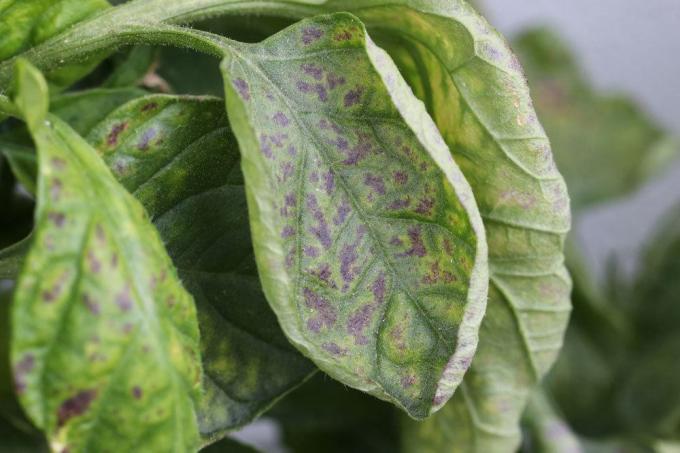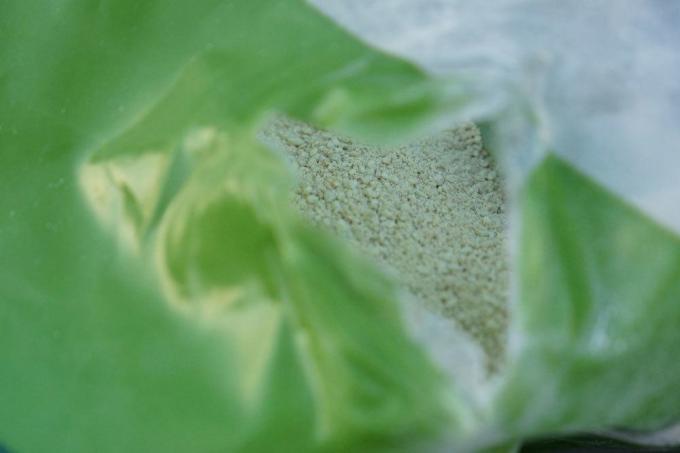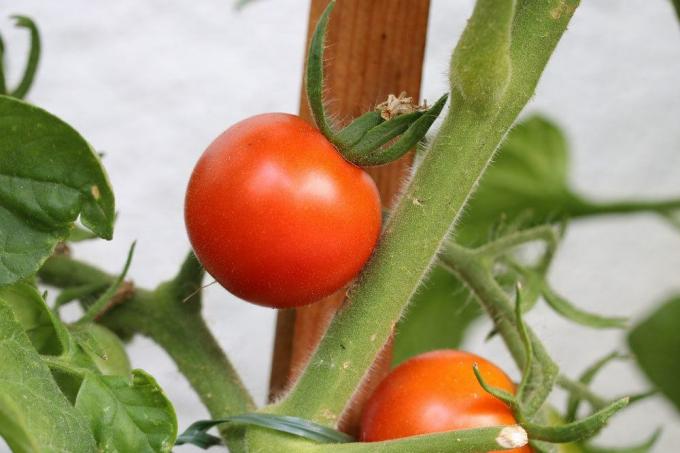
table of contents
- Late blight - origin
- Damage image
- Occurrence
- Combat
- prevention
- Pouring rules
- Resistant varieties
- Protective measures
Anyone who knows the taste of a freshly harvested tomato from their own garden will never want to eat other tomatoes again. In principle, the plants are quite easy to care for and promise a rich harvest. However, in some years this doesn't work at all. Instead, the leaves and fruits of one or more plants turn brown within a few days. They fall off and there is no harvest.
Late blight - origin
What causes late blight in tomatoes?
Brown blight is an infection with the fungus Phytophthora infestans. In order for this fungus to spread, two main factors are needed: the fungus or spores of these must be present and your tomato plant must be exposed to moisture for an extended period of time will. In addition, average temperatures of around 15 ° C are useful. Dry, warm summer weather with temperatures of 20 ° C and more do not give late blight and brown rot a chance.

Potato plants
The fungus also feels good on potato plants or seed potatoes. So a potato field next to your garden is definitely a risk of disease. The wind can transfer the spores from potatoes to tomato plants if they are too close together. Infection from tools, buckets, soil or trellis is also quite possible.
Damage image
What does the brown rot look like on tomato plants?
The first signs of a disease are brown spots, which usually first appear on the leaves but can also appear on the stems. In a short time, the leaves turn black, curl up and then fall off. Then the tomatoes also get brown to blackish spots. The fungus makes them hard and inedible. Both ripe and unripe fruits are affected. Since brown rot spreads very quickly, you should fight the fungus as quickly and radically as possible.

Occurrence
When and / or where does late blight occur particularly often?
Like most mushrooms, the Phytophthora infestans also loves humid climates. Therefore, it occurs mainly in rainy summers. Temperatures around 15 ° C and occasional drizzle are ideal for the spread of Phytophthora infestans, a typical north German summer. Outdoor tomatoes are more frequently or more severely affected than plants in the greenhouse. But even there, your tomato plants are not really safe from the fungus. In dense plantations, the fungus can spread particularly quickly from one plant to the next.

Requirements for a good tomato harvest:
- warmth
- Sun
- dry air or dry leaves
- water abundantly
Combat
How can I safely combat late blight?
If your tomatoes are already infected, the late blight can hardly be combated. Your only chance is to discover the infestation early and radically remove all infected parts of the plant immediately. Do not throw the clippings on your compost, because that way you will never get rid of the fungus. He winters there very well. If you later spread the ripe compost in your garden, this will spread the fungal spores all over the place. As soon as you put potatoes or plant tomatoes, the fungus continues to spread and you have to fight it again.
prevention
How can I prevent late blight or brown rot?
It is much easier to prevent late blight than to control it. The most important preventive measures against late blight and brown rot include sun and wind. Both prevent the tomato leaves from staying moist for long after a rain shower. Unfortunately, both of them can hardly be influenced by the gardener. However, you can choose an appropriate location for your tomato plants: sunny and not sheltered from the wind. With a roof you can also protect the plants from rain. Loose soil prevents waterlogging. A minimum distance of around 50 to 70 centimeters between the individual plants helps prevent the plants from touching each other and thus infecting each other.
control
So that you can react in good time to any fungal attack, check your tomatoes regularly. You can start with the young plants, but no later than June. Remove the lower leaves of the plants until the first shoot, where fruit clusters are formed. In this way you reduce the risk of fungal infestation and a distribution of the spores through the irrigation water. As a precaution, you can dust the tomato plants with non-toxic algae lime or rock flour, this protects the leaves from penetration of fungal spores and reduces moisture.

Field horsetail
A few times a week, spray your tomato plants with a cooled tea made from field horsetail. To do this, pour about a liter of boiling water over five grams of dried field horsetail. Let the tea steep for five to ten minutes and then strain it. Alternatively, you can also use a tea bag. If you want to use fresh horsetail, you need around 100 to 150 grams for one liter of tea. The tea should only be sprayed when it is completely cool, otherwise your tomato plant will be burned. So that the taste of the field horsetail does not pass over to the harvested fruit, stop spraying the plant a few days in advance.
Pouring rules
Do I have to pay attention to anything when watering my tomato plants?
The spores of Phytophthora infestans are not only spread by wind but also with water, for example by rain but also by improper watering. The best way to water your tomato plants is to use water with little lime, preferably from the rain barrel. Water directly at the roots of each plant with a soft stream. The less water hits the leaves, the better it is.
Resistant varieties
Are there varieties that are resistant to brown rot?
Since late blight can quickly become a problem and, in the worst case, threaten the entire harvest, breeders have developed resilient varieties. Unfortunately, these are not completely resistant either. With good care, however, you have a real chance of getting a rich tomato harvest despite adverse weather, without constantly having to fight fungal infestation or other diseases. Inquire about resistant varieties when buying your young plants or seeds.
Protective measures
How do I protect my tomatoes from re-infestation?
If you have ever had to fight brown rot, you should do everything possible to protect your tomatoes from it in the future. This applies not only to the plants of the current year but especially to the years to come. Disinfect all tools that may have come into contact with the fungal spores. Treat buckets and climbing aids in the same way, if you have used them. You do not need a special disinfectant for this, boiling water is sufficient. If available, you can also use a gas burner for this. However, caution is advised here.

Change of location
In the next year, plant your tomatoes in a different place. This should be as far away as possible from the previous year's location where your late blight tomatoes were. Just as important is the distance from areas where you planted potatoes last year, because here too the earth could be infected with brown rot.
Glasshouse
If you live in an area with occasional humid and / or cool summers, plant yours Tomatoes are best in a greenhouse, as the risk of late blight is clear less. As a precaution, replace the earth every spring. Again, think of clean tools (spade, wheelbarrow, shovel, etc.). If you don't have a greenhouse, build a small roof over your tomato plants. This offers at least minimal protection from the fungal spores and can also be built quickly if a longer period of rain is announced.
